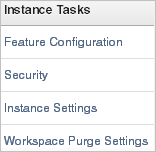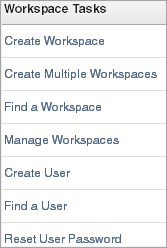2.1 What Is an Instance Administrator?
Instance administrators are responsible for managing an entire Oracle Application Express instance.
In Oracle Application Express, users log in to a shared work area called a workspace. These users are divided into three primary roles:
-
Workspace administrators are developers who also perform administrator tasks specific to their workspace such as managing user accounts, monitoring workspace activity, and viewing log files. See "Workspace and Application Administration".
-
Instance administrators are superusers that manage the entire hosted instance using the Oracle Application Express Administration Services application.
2.1.1 About the Instance Administration Home Page
The Instance Administration home page is the starting point for managing an entire Oracle Application Express instance.

Description of the illustration home_pg.gif
Four icons display at the top of the page:
-
Manage Requests. See "Managing Workspace and Change Requests".
-
Manage Instance. See "About the Manage Instance Page".
-
Manage Workspace. See "About the Manage Workspaces Page".
-
Monitor Activity. See "Monitoring Activity Across a Development Instance".
About the System Message Region
The System Message region display in the center of the page. Use this region to communicate with other users in the workspace. To add a system message, click the Edit System Message icon. See "Defining a System Message".
2.1.1.1 About Instance Tasks

Description of the illustration hm_instance_tasks.gif
Use the Instance Tasks list to access the following tasks:
-
Feature Configuration. See "Managing Feature Configuration".
-
Security. See "Configuring Security Settings".
-
Instance Settings. See "Managing Instance Settings".
-
Workspace Purge Settings. See "Purging Inactive Workspaces".
2.1.1.2 About Workspace Tasks

Description of the illustration hm_wrkspc_tasks.gif
Use the Workspace Tasks list to access the following tasks:
-
Create Workspace. See "Creating Workspaces".
-
Create Multiple Workspaces. See "Creating Multiple Workspaces".
-
Find a Workspace. See "Performing a Workspace Search".
-
Manage Workspaces. See "Managing Existing Workspaces".
-
Create User. See "Creating New User Accounts".
-
Find a User. See "Managing Users in an Oracle Application Express Instance".
-
Reset User Password. See "Editing an Existing User Account".
2.1.1.3 About Language Selector
Displays the default language for this Oracle Application Express instance.
2.1.1.4 Accessibility Mode
Select the accessibility mode for this instance. See "Appendix E: Accessibility in Oracle Application Express" in Oracle Application Express Application Builder User's Guide, "Using Screen Reader Mode in Your Database Applications" in Oracle Application Express Application Builder User's Guide, "Using High Contrast Mode in Your Database Applications" in Oracle Application Express Application Builder User's Guide.
2.1.2 About the Manage Instance Page
Instance administrators use the Manage Instance page to configure an Oracle Application Express instance. This topic provides information about the links on this page.
Instance Settings contains the following links:
-
Feature Configuration. See "Managing Feature Configuration".
-
Security. See "Configuring Security Settings".
-
Instance Settings. See "Configuring Instance Settings".
-
Workspace Purge Settings. See "Purging Inactive Workspaces".
About Manage Shared Components
Manage Shared Components contains the following link:
-
Packaged Database Applications. See "Viewing Information About Installed Packaged Database Applications".
-
Packaged Websheet Applications. See "Viewing Packaged Websheet Applications".
-
Monitor Packaged Application Installations. See "Monitoring the Progress Packaged Application Installations".
-
Public Themes. See "Managing Public Themes".
-
Template Applications. See "Managing Template Applications".
Manage Meta Data contains the following links:
-
Session State. See "Managing Session State".
-
Mail Queue. See "Managing the Mail Queue".
-
Installed Translations. See "Viewing Installed Translations".
-
Interactive Report Subscriptions. See "Managing Interactive Report Subscriptions".
Messages contains the following links:
-
Define Login Message. See "Defining a Login Message"
-
Set System Message. See "Defining a System Message"
-
Manage Site-Specific Tasks. See "Creating a Site-Specific Tasks List".
Manage Logs and Files contains the following links:
-
Set SQL Workshop logs. See "Deleting SQL Workshop Logs".
-
Page View Activity Log, with option to truncate. See "Deleting Page View Activity Log Entries".
-
Developer Activity Log, with option to truncate. See "Deleting Developer Activity Log Entries".
-
External Click Counting Log, with option to truncate. See "Deleting Click Counting Log Entries"
-
Login Access Log. See "Deleting the Login Access Log".
-
Manage Log Interval. See "Managing Log Intervals".
Self Service Sign Up contains the following links:
-
Manage New Service Signup Wizard. See "Managing a New Service Signup Wizard".
-
Run New Service Signup Wizard. See "Running a New Service Signup Wizard"
2.1.3 About the Manage Workspaces Page
Instance administrators use the Manage Workspaces page to manage workspaces for an Oracle Application Express instance. This topic provides information about the links on this page.
Manage Workspaces contains the following links:
-
Create Workspace. See "Creating Workspaces".
-
Remove Workspace. See "Deleting a Workspace".
-
Lock Workspace. See "Locking a Workspace".
-
Manage Workspace to Schema Assignments. See "Managing Workspace to Schema Assignments".
-
Manage Developers and Users. See "Managing Users in an Oracle Application Express Instance".
-
Manage Component Availability. See "Managing Component Availability".
Use Workspace Reports to access the following links:
-
Existing Workspaces. See "Managing Existing Workspaces".
-
Workspace Details. See "Viewing Workspace Details".
-
Workspace Database Privileges. See "Viewing Workspace Database Privileges".
-
Workspaces with Only Sample Application. See "Viewing Workspaces with Only a Sample Application".
-
Manage File Utilization. See "Viewing File Size and File Count by Workspace".
Use Export Import to access the following links:
-
Import Workspaces. See "Importing a Workspace".
-
Export Workspaces. See "Exporting a Workspace".
Use Manage Workspaces to access the following links:
-
Application Attributes. See "Viewing Application Attributes".
-
Build Status. See "Changing Application Build Status Set During Deployment".
-
Parsing Schemas. See "Viewing the Parsing Schemas Report".